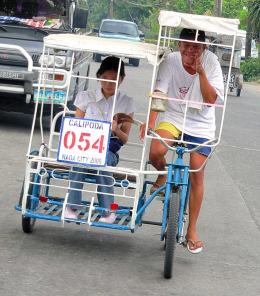First, for our American friends, there are two official languages in the Philippines: English and Filipino. Filipino is based primarily on Tagalog (pronounced tah-gah´-log), one of 171 native languages spoken throughout the island nation. English is the second national language and is the language in which you will find most official signage around the country.

In many Tagalog-to-English dictionaries, the noun “padyak” (pronounced pahd´-yahk) is translated as the act of stamping one’s feet. Somewhere along the road of language evolution, the folks in the Bicol region on the island of Luzon began to apply the term to their local pedicabs – economical, human-powered transit. While similar to rikshaws and pedicabs in other Asian countries, the Filipino padyak is unique in that the rider is seated in a sidecar, beside the bicycle, rather than behind it.
And, as you can see, those sidecars can carry a lot of other things besides people.



So, Why Is Padyaks Our Name?
Just as a padyak is a used for short-distance hauling, we have now become a short-to-medium distance carrier of balikbayan cargo from south-central Ohio, destined for the Philippines.
Therefore, we believed that naming our business “Padyaks” would be a fitting tribute to the many hard-working Filipinos who do their part to literally move their local economies.
For that, we gladly stamp our feet!


Our padyak here in the U.S., custom-built in Tobaco City, Philippines.



